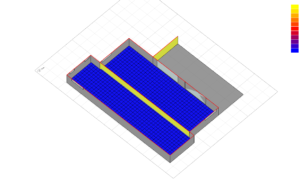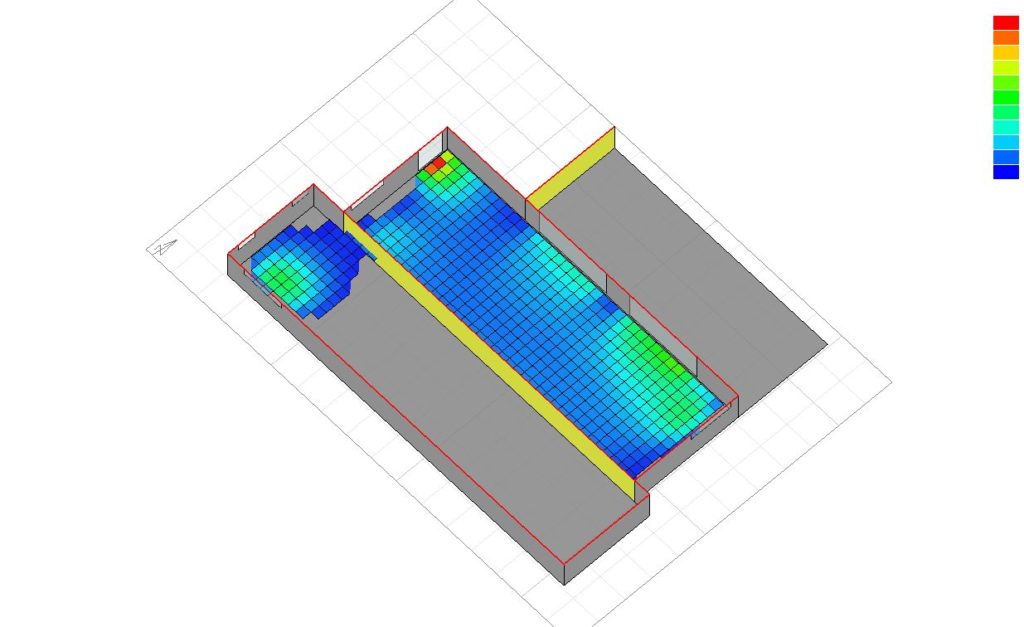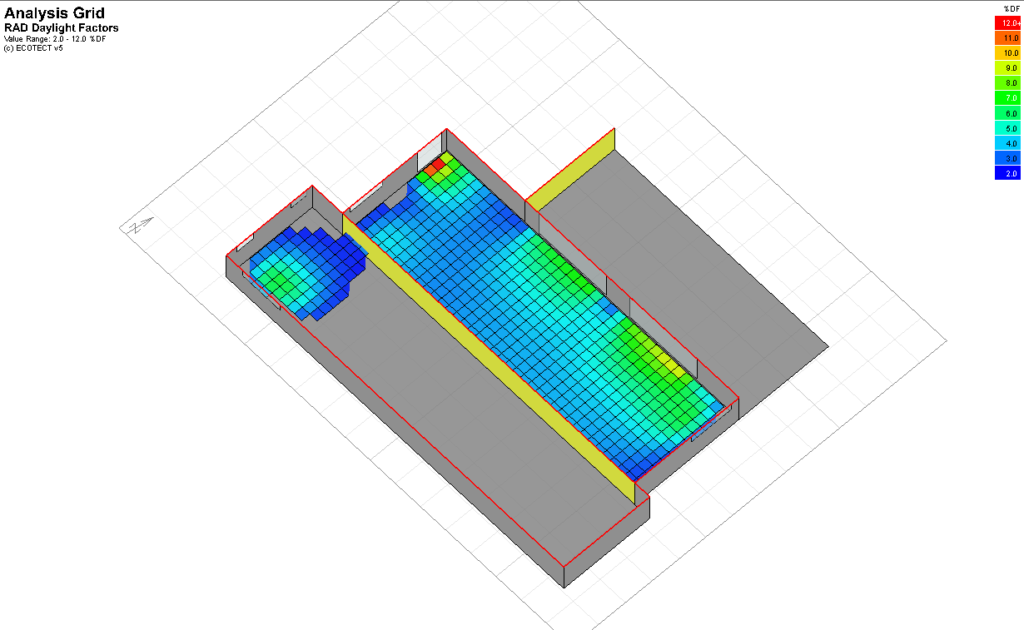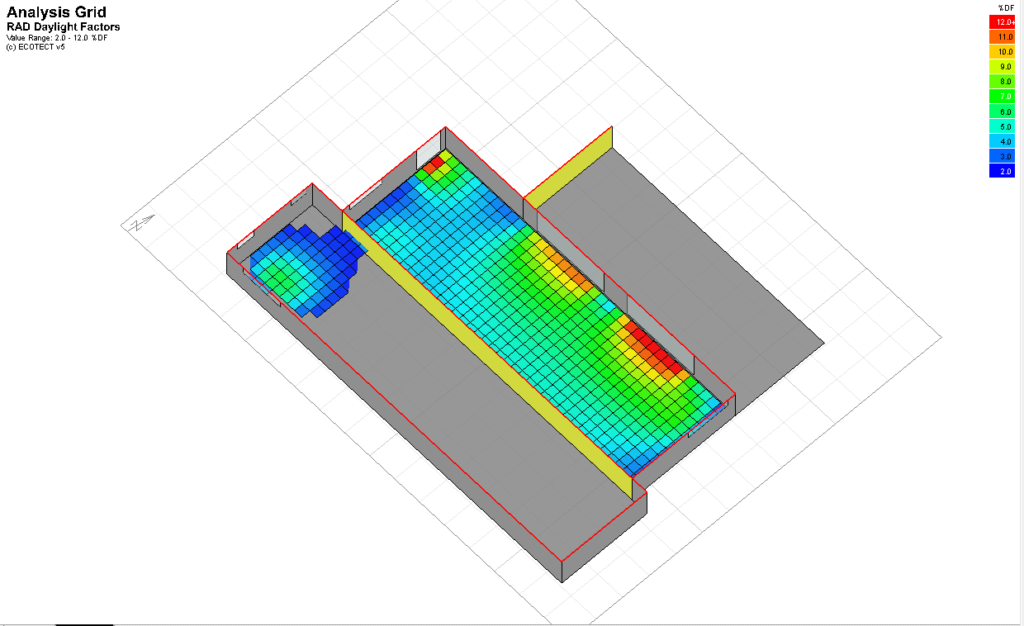Daylight Modelling to Inform the Design
Target
- A DF of 10% will always stop people turning on lights
- A DF of 3% is deemed “adequate”
- Target: 5% to most of the floor.
- But: minimise glare, moderate window sizes
Method
- Ecotect and Radiance
- Basic export from Revit (use VG to shown only walls
- Trace one big zone in ecotect and add partitions. Use custom custom to set “default” reflectacces
- Save the GRD files
- Use a standard grid: 2 – 12, and BLUE-GREEN-RED and clip out <2
Results
Blackbox
Don’t be a muppet. Do a blackbox first. You can’t see the scale, but the maximum is 0.1 DF (ie. close to zero), so we have a sealed box.

Looking good: <1% DF if there are black windows
First Run
- VLT 70% (ie. frame + 80% glass)
- Patio is 50% nominal – see below for more work on this.
- Ok, so KLD (top right) is good. The east (RHS) corner could use a bit more. Currently the windows is 1500W, so try a 1800W
- The hallway is shit: add the top light (2500×900 splashback + 2500×450 high level)
- The entry (top left) need fixing. Add glass door.
- The bedrooms are all similiar. They are around 5% DF but dimmer in parts. Try 1800W windows.
Results
The changes above were incorporated (all 4). The results (ie photos and impressions, and maybe a light meter test) to be added.
Using Daylight Modelling to Select a Deck Roof
What VLT should the deck be, and what material should I make it from?
Materials:
- Polycarb: cheap, easy to cut and fix. Brittle after a decade or so; can look dirty.
- Fibreglass: Amperlite says it is best (more durable) more hot climates; needs a ‘gel coat’ to stop delam
- Multicell polycarb: expensive; better performance (see graph – not that radical)
Is multicell better in regards to:
- Appearance: yes, but details are important at the end.
- VLT v SHGC: A bit, but not really – see graph below.
- U-Value: Yes, but this is not really relevant unless one side is conditioned (not the case for the deck)
What VLT?
- Fix the window VLT at 60% and modify deck vlt to get good daylight into the kitchen. Use the lowest possible for good daylight to reduce heat gain.
We can model just the living room in Ecotect and Radiance to find
No muppets: blackbox first (okay, not shown)
Above : Deck roof VLT 0%: Acceptable, but back of room will be darkish (2% DF).
Above: VLT of 30%: for deck. This provides 4.0% DF even to the back of the room. This is the lower limit.
VLT of 60%
Above: 60% VLT. This is pretty damn bright, and would be the upper limit.
Deck Roof Design Results
- Use polycarb or fibreglass, not multicell.
- Use VLT of 30 to 60%
Insulated Panel for the Deck Roof?
We want to use insulated panel (ie. EPS foam with a thin colourboard skin) to improve comfort to the deck. The deck is currently polycarbonate. This works well in Winter and Spring. In Summer, a minimal shade cloth (to 75% of area) improves comfort but it’s too hot in the middle of Summer. Hence: add insulated panel is an option.
The key here is reducing radiant heat by reducing the inner (i.e. bottom) surface temperature of the deck roof.
How thick a panel should I use?
Firstly we assume a few things:
Air is 28°C, humidty is 60%, upper surface is 60°C (in the sun). By working out heat transfer (convection on the inner surface and conduction through the panel), we can find the inner surface temperature and then predict the comfort levels.
To reduce the inner surface temperature from 45°C (PMV 2.5 = hot!) with R0.5 (20mm) to, say 32°C (PMV = 1.5 = still pretty warm) we use R1.5 (50-75mm). Below R2.0 (75mm) gains are limited.
Therefore, we select 50mm (minimum) to 75mm (preferred) thickness.
Wind Analysis
Summary
- Wind for natural ventiation (i.e. when it’s hot) is from the EAST and NORTH-EAST
- Year-round wind is from the North or South
Detail
All hours Brisbane wind rose (70% of the year there is wind):
Wind > 0.5m/s, temperature >22°C rose: 32% of the year:
So, when we want it, winds typically come from the NE quadrant in Brisbane.
Energy Modelling to Inform the Design
The house was modelling in both IES and Accurate. The NatHERS report I did for certification is attached. This does not really try to model the house performance, but just shows it’s a least 7 stars. Due to AccuRate limitations, PCMs and building sealing cannot be accurately modelled.
Update 17/9/2016: We have just finished the first Winter. This is The model did not account for a large tree to the NW of the tree, which blocks Winter (and Summer) sun. Generally no heating was required even at night. Some nights were cold and we used a terrible 1kW electric heater for morning warm-up. This was run for about 2 hours per day over 20 days. It runs about 30% of the time when on. This is 4.3 MJ/m²/year (same as modelled figure). It appears the tree’s shade (lack of solar gain) is ‘cancelling out’ the PCM and building sealing.
Accurate was good to test options: it’s faster but less sophiscated compared to IES (or EnergyPlus, etc). The summary of modelling is:
- IES and FR5 results are significantly different.It is difficult to get to the bottom of why – I gave up quickly.
- Shading is important (Scenario 3 to 4)
- Ceiling fans are great
- Insulation (particularly floor) is good for heating
- Thermal mass is good (even in Brisbane).
- If you do all this the above, super windows and superheavyweight provide only minor benefits.
The detailed results are below:
And as HTML:
| Name | Note | Walls R_total |
Roof R_total |
Floor R_ttal |
Windows | Heat MJ/m² |
Cool MJ/m² |
Total MJ/m² |
Stars |
| 2 Bad windows | This is NCC minimum without shading | 2.8 | 4.1 | 0.0 | U7 SHGC 0.77 | 31 | 183 | 214 | ☆ |
| 3 Add shading | This is NCC minimum | 2.8 | 4.1 | 0.0 | U7 SHGC 0.77 | 31 | 148 | 179 | ★ |
| 4 Add deck shading | 2.8 | 4.1 | 0.0 | U7 SHGC 0.77 | 39 | 96 | 135 | ★★ | |
| 5 Add better windows | 2.8 | 4.1 | 0.0 | U5 SHGC .50 | 39 | 73 | 112 | ★★☆ | |
| 6 Add more insulation | 4.5 | 6.0 | 2.0 | U5 SHGC .50 | 11 | 70 | 81 | ★★★☆ | |
| 7 Add ceiling fans | 4.5 | 6.0 | 2.0 | U5 SHGC .50 | 12 | 43 | 55 | ★★★★☆ | |
| 9 Add movable shading lourves | 4.5 | 6.0 | 2.0 | U5 SHGC .50 | 5 | 46 | 51 | ★★★★★ | |
| 10 Add detailed east/west window shading | 4.5 | 6.0 | 2.0 | U5 SHGC .50 | 4 | 43 | 47 | ★★★★★ | |
| 11 Add lighted coloured roof and walls | 4.5 | 6.0 | 2.0 | U5 SHGC .50 | 4.3 | 41 | 45.3 | ★★★★★ | |
| 14 Add medium weight walls and floor | Final rating | 4.5 | 6.0 | 2.0 | U5 SHGC .50 | 4.7 | 39 | 43.7 | ★★★★★☆ |
| 12 Test only: Super windows | Gets worse – do not use | 4.5 | 6.0 | 2.0 | U2.7 SHGC0.64 | 0.7 | 48 | 48.7 | ★★★★★ |
Peak Load Modelling to Inform the Design
CAMEL is the standard in the HVAC industry to estimate cooling (and heating) loads in a building. A similiar process as with the energy was undertaken to determine ways to reduce the peak load.
Glazing
Or, “What glazing should you use in Brisbane for a house?”
The following is based on:
- Sensible amounts of glazing. In this instance glazing is 30% of the external wall area. See the house structure for an overview.
- Well-shaded glazing – this typically means minimal west/east glazing and overhangs to the north.
- Sound and other considerations are not … considered.
Windows are a necessary evil – necessary because we like views and evil because they are expensive leaky and provide next-to-no insulation.
So the question becomes: how can I maintain views and limit heat entry into the house.
VLT and SHGC
We need a VLT of 40-80% for nice views. Say about 60% which looks pretty clear. In Brisbane we want a lowish SHGC say 0.50 too. This lets in half of the sun’s heat. (If direct sun hits the windows in Summer you’ll overheat: so if they are not shaded you’re in trouble and would select a lower SHGC.) It allows some Winter warm up.
Single or Double Glazing, U Value
Single glazing was selected, with a low-e coating. This provides good performance in summer, as the low-e coating reduces radiant solar gains. It is cheaper than double glazing. Double glazing has similiar VLT/SHGC performance. For example, GJames DGU EnergyTechClear (Low E) has SHGC 0.61 and VLT 73% while SGU Solect Sttel (Low E) has SHGC 0.59 and VLT 68%. So double glazing is not much better on the SHGC/VLT front.
Single glazing U-value is about U3.6. Double glazing U-value is about U2.0. So it’s better
- Glass and frame: U5.5
- Glass: Low-E on inside surface, single glazed.
Format
Casement windows were selected
Insulation Selection and Design
Floor
Options to insulate the floor (90m2) include the following:
- aircell over the joists, $900. Probably under-performs in the medium term due to dust on surfaces and is compressed over the joist. Easy but not great.
- Infill with rigid foam between joists. Medium effort. Cheaper with generic polystrene panels.
- Spray foam. Great air seal. Possible toxic problems if poorly mixed. Uncommon in queensland.
Infill is choosen. Options for rigid board products:
- XPS: High cost. Low greenness. Good for wet. Very rigid. High costs. Uses HBCD as flame retardent, which is questionable toxicity. Vapour and air barrier. High CO2-equiv blower. $2200 / 90m2 knauf bunnings 50mm
- EPS: Low – medium cost. High greenness. The only one which is somewhat vapour permeable. Good for wet. Ok pentane blower. Kooltherm 40mm $96 / 90m2.
- PolyIso: Higher costs. High greenness. Urethane. Medium rigid. Moisture sensitive. Foil faced so vapour and air barrier (if taped). Ok Pentane blower.
- Polyurethene: Unknown. lighter density blown with water.
Walls
Roof / Ceiling
Steps and Stairs
Design
The key dimensions are rise and going. See the diagram below. The Construction Code and Neufert’s Architectural Guide are good guides. A reference to 270G:190R means a stair with a rise of 190mm and a going of 270mm.
- 270G 170R : Quoted by Neufert as the ideal step. This is a ratio of 1.0:1.7
- NCC says 2R+G must be between 550 and 770
- Outside steps should be larger (eg. 380G 180R)
For the deck and garden stairs, I made them similiar width and the small anglde (ie. rise:going ratio). This looked a lot better. See rendering below.


Documentation
Revit (by AutoDesk) is pretty good for stair design, but takes a bit to learn. It can be frustrating. A good alternative is simple 2D drawings. For some stair a large plywood sheet can be used to draw the drawing “full size”, as shown in the image below. See attached for my drawings (exported from Revit) of the stairs. Note the “cumulative” dimensions which were added to enable easier marking out.
Materials
Wet Areas and Marmoleum (aka Linoleum)
Marmoleum was chosen for wet areas (toilet, bath, laundry) It is not common anymore. It’s made of flax seed and a natural fibre backing. It’s greener in that it’s from a renewable plant product, longer lasting and easier to dispose of, when compared to vinyl flooring.
Some notes of my experience:
- Performed well. No damage for repeated flooding of laundry (oops). No humidity problems. No “resealing” was done.
- Hardwearing. No damage after 3 years. It’s not bulletproof and will mark/cut with sharp objects (e.g. anvil). In practice it’s fine.
- Harder to find. Flooring Xtra and Andersons in Brisbane stocked it. Fewer colours to choose from.
- Needs professional installation if coved joints are used.
- Coved joints in bathroom are very easy to clean.
My specification was:
To supply and install Forbo Marmoleum 171 Cement to Entry, Larder, Bath and WC. To heat weld all joins. To cove Bath and WC 150mm. To use low VOC adhesive.


